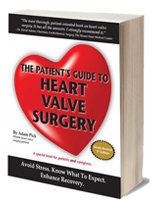Thickened Mitral Valve Leaflets: What Should Patients Know?
Written By: Allison DeMajistre, BSN, RN, CCRN
Medical Expert: Marc Gerdisch, MD, Chief of Cardiac Surgery, Franciscan Health, Indianapolis, Indiana
Reviewed By: Adam Pick, Patient Advocate, Author & Website Founder
Published: August 14, 2025
The mitral valve is arguably the most complex structure in the cardiovascular system, primarily due to its intricate anatomy, dynamic function, and the significant role it plays in maintaining efficient blood flow in the heart. It consists of several distinct parts that must work together harmoniously including the mitral annulus, anterior and posterior leaflets, chordae tendineae, the papillary muscles, and the left ventricular and atrial walls. There is no doubt it is a wondrous structure. Unfortunately, the more moving parts a structure has that must work together, the greater the chance of something going wrong, which is probably the reason the mitral valve is the one most associated with disease.
Fortunately, many patients with mild mitral valve problems – like prolapse and leaflet thickening – never have any disease progression and don’t require any type of intervention. Still, patients must understand the issue in case the problem continues to advance.
We received an important question concerning this topic from Fazila, who asked, “For the mitral valve, what does a mildly thickened mitral leaflet mean? How can that lead to health issues and surgery?” To answer Fazila’s question, Adam Pick, the founder of HeartValveSurgery.com, met with Dr. Marc Gerdisch, the Chief of Cardiac Surgery at Franciscan Health in Indianapolis, Indiana. Dr. Gerdisch is always an excellent resource for patient questions, having performed over 5,000 heart valve surgeries and successfully treated more than 125 patients in our community.
Facts About Mitral Valve Thickening
Here are the key insights shared by Dr. Gerdisch:
- An echocardiogram can help reveal essential information about the heart. “That’s an interesting question, especially for an imaging geek like me,” said Dr. Gerdisch. “When I look at an echocardiogram, I am really interested in everything about the study because I think it’s important to communicate that information to the patient. So, I’ll start with the aortic leaflets. When we see changes in the aortic leaflets, such as sclerosis or stiffening, it’s an indicator that there is a risk of atherosclerosis and possibly hypertension. When we see it in a mitral valve, it can be an indicator of a systemic issue. For example, hypertension is there because of elevated pressure in the left ventricle. But it can also be the prelude to myxomatous disease of the valve, which means they have thickening of the valve that could potentially lead to prolapse and later to a leaking valve.”
- The progression of mitral prolapse is not typical. Dr. Gerdisch explained that when people have mitral prolapse, it also causes some leaking, but only about five percent of them go on to need any type of intervention. If the prolapse is moderate and has leakage, that five percent advances to 50 percent. Dr. Gerdisch said, “Make sure you are taking good care of yourself, stay in good health, and pay attention to your blood pressure. And then, depending on Fazila’s physiology and how her doctors follow her, she may need another echocardiogram in three to five years.
Thanks Dr. Gerdisch and Franciscan Health!
On behalf of all the patients in our community, thank you, Dr. Marc Gerdisch, for everything you and your team are doing at Franciscan Health in Indianapolis, Indiana!
Related Links:
- Surgeon Q&A: Will I Need Mitral Valve Surgery?
- Cardiac Innovation: Minimally-Invasive Mitral Valve Surgery
- Patient Webinar: “Ask Dr. Gerdisch Anything”
Keep on tickin,
Adam
P.S. For the deaf and hard-of-hearing members of our patient community, we have provided a written transcript of our interview with Dr. Gerdisch below.
Video Transcript:
Adam Pick: Hi everybody, it’s Adam with HeartValveSurgery.com and we’re in Los Angeles, California at the Society of Thoracic Surgeons Conference. I am thrilled to be joined by Dr. Marc Gerdisch who’s the Chief of Cardiac Surgery at Franciscan Health in Indianapolis, Indiana.
Dr. Gerdisch, you and I have known each other for over 10 years. You’ve successfully treated over 100 patients in our community. Thanks so much for being with me today.
Dr. Marc Gerdisch: Thanks Adam.
Adam Pick: We’re getting lots of new data here at STS. Presentations, talks, you’re giving them. We’re also getting patient questions. And this one comes in from Fazila who asks, “For the mitral valve, what does a mildly thickened mitral leaflet mean? How can that lead to health issues and surgery?”
Dr. Marc Gerdisch: So it’s a really interesting question, especially for an imaging geek like me.
When I look at an echocardiogram, I really am interested in everything about the study because I think it’s important to communicate that information to the patient. So I’m actually going to start with aortic leaflets. When we see any changes in the aortic leaflets, sclerosis, stiffening, we kind of know that’s a little bit of an indicator of risk of atherosclerosis and maybe hypertension.
When we see it in a mitral valve, it can, it can be an indicator of systemic issue. For example, hypertension in there because of elevated pressure in the left ventricle. But it can also be the prelude to, uh, demonstrating that the person has myxomatous disease of the valve. Meaning that they have thickening of the valve that would later potentially lead to prolapse but then potentially lead to a leaking valve.
Now I don’t want to alarm anybody with that one because as I think I’ve mentioned before, somebody who has a mild prolapse and leak from their valve, only about 5 percent of those people go on to ever needing anything done. Moderate, about 50 percent of them do. So in this case, what I would say is nothing.
Make sure that you’re taking good care of yourself, that, you know, globally good health and paying attention to your blood pressure. And then maybe, depending on her physiology and how people follow her, maybe another echo in several years. Several years, not even two years, but maybe three, four, five years.
Adam Pick: Great. Well, Fazila, I hope that helped you. I know it helped me. And Dr. Gerdisch, as always, thanks for everything you and your team are doing at Franciscan Health in Indianapolis, Indiana.





